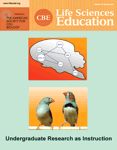Redesigning a Large-Enrollment Introductory Biology Course
Abstract
Using an action research model, biology faculty examined, implemented, and evaluated learner-centered instructional strategies to reach the goal of increasing the level of student achievement in the introductory biology course BIO 181: Unity of Life I, which was characterized by both high enrollments and a high DFW rate. Outcomes included the creation and implementation of an assessment tool for biology content knowledge and attitudes, development and implementation of a common syllabus, modification of the course to include learner-centered instructional strategies, and the collection and analysis of data to evaluate the success of the modifications. The redesigned course resulted in greater student success, as measured by grades (reduced %DFW and increased %AB) as well as by achievement in the course assessment tool. In addition, the redesigned course led to increased student satisfaction and greater consistency among different sections. These findings have important implications for both students and institutions, as the significantly lower DFW rate means that fewer students have to retake the course.
INTRODUCTION
Research in biology has changed dramatically over the past three decades due to the development of new technologies, such as recombinant DNA and polymerase chain reaction, which have led to new questions and approaches and the emergence of new fields of study such as proteomics and bioinformatics. However, according to the National Academies (2002, p. 1), “In contrast, undergraduate biology education is still geared to the biology of the past.… [M]ost courses, especially those for first-year students, are still primarily lecture-based, and do not convey the exciting reality of biology.”
Since 1990, reform in American science education has been led by documents such as Science for All Americans: Project 2061, Benchmarks for Science Literacy, and the National Science Education Standards (American Association for the Advancement of Science [AAAS], 1989, 1993; National Research Council [NRC], 1996). These documents call for a major shift in not only what is taught but also how it is taught in kindergarten through 12th grade. Federal dollars have been appropriated through several programs, including the U.S. Department of Education (Eisenhower Secondary Mathematics and Science Education Program and the Bush No Child Left Behind Act), to provide professional development opportunities for states to instigate the suggested changes and monitor student performance. Colleges and universities have been involved as partner institutions that developed and offered various workshops and courses for in-service and preservice science teachers.
Efforts to research biology, chemistry, and science education in general have provided valuable insights (Herron and Nurrenbern, 1999; Klymkowsky et al., 2003; Stokstad, 2003; Yehudit et al., 2003; Handelsman et al., 2004; Mazur, 2009) on the effectiveness of various pedagogical interventions. However, the physics education research community has led the effort to implement and research the effectiveness of interactive methodologies (McDermott, 1991, 1996; Hestenes et al., 1992; Hake, 1998; Redish, 1999; Meltzer and Manivannan, 2002; Rebello and Zollman, 2004; Heron and Meltzer, 2005; Wieman and Perkins, 2005; Mason and Singh, 2010). The research from the physics community stresses the importance for students to be engaged in problem solving, modeling, discussions, and other modes of involving students in their own learning. Many of the pedagogies included in the revision described in this article are based on these efforts and the research on how people learn (Bransford et al., 2000).
Engaging students in their own learning whether by interaction with the content, peers, or the course instructor increases learning (Slater et al., 2006). Classrooms that utilize active-learning strategies are noisy. Students are debating ideas, asking questions and comparing answers to what is known, using evidence to develop explanations, considering alternatives, communicating their ideas, and, upon reflection, often changing their ideas. Sometimes students work in groups to collect data in real-life contexts or apply knowledge gained in the classroom to societal problems. These increased interactions with content and peers make thinking explicit. Active-learning strategies simulate the processes involved in scientific inquiry and appeal to many students because they accommodate different interest and learning preferences (Ueckert and Gess-Newsome, 2007).
Science is an active process. It involves asking questions, making observations, and collecting and analyzing data, which are then used to justify explanations. Active learning is similar to the process of science as it requires students to engage with the content and with others in order to answer questions and solve problems, unveil prior ideas, and make connections between ideas. As recognized in the National Science Education Standards, “Student understanding is actively constructed through individual and social processes” (NRC, 1996, p. 29). Learning involves connecting what we already know with new knowledge. This is an active process and requires students to take responsibility for their own learning. Learners must recognize what they know and what they still have questions about (metacognition). Understanding a concept is often manifested when students are asked a question in which they must transfer prior knowledge and understandings to a new context. This transfer occurs only if learners are aware of the principles underlying their thinking (Bransford et al., 2000; NRC, 2000). The research on learning implies that students need multiple opportunities to think deeply and purposefully about the content and to gain feedback on their learning (Ueckert and Gess-Newsome, 2008).
We encountered several challenges in teaching BIO 181: Unity of Life I that are documented in the literature on large lecture-based classes, including 1) ill-prepared students, 2) poor attendance, 3) diverse learning abilities, 4) passivity, and 5) lack of student feedback (Slater et al., 2006; Freeman et al., 2007; Walker et al., 2008). The academic problem addressed in this study was the low level of student success in the course as reflected by one of the highest rates of students who received a D, an F, or a W at our university. For the previous seven semesters, the DFW rate for students taking BIO 181 varied from 28 to 51% (depending on the section). This DFW rate not only impacted the potential of students to enter the major of their choice but also contributed to overenrollment in BIO 181 and the problem of limited lab space. Our goal was to use learner-centered education strategies to increase the success of students in BIO 181 and to increase consistency among sections.
Changing how things have been done traditionally is often met with resistance from both faculty and students, and the impact is often limited to a single professor making the changes (Brainard, 2007). To make a more widespread impact on BIO 181, a systematic approach was used. Principles of instructional design suggested that the process should begin with an analysis of the student population and identification of learning outcomes. Following the implementation of changes, data should then be collected and analyzed to guide continual curricular improvements. These guidelines were used to redesign BIO 181.
The reform project discussed in this article was developed using these central elements of science education reform (AAAS, 1989, 1993; NRC, 1996): collaboration on course goals and content, establishment of a collegial climate in which ideas are openly discussed and refined, and deliberate design of an assessment plan that aligned with course goals and would guide future course development. The project was partially funded by an Arizona Board of Regents Learner-Centered Education grant.
The course redesign had five components: 1) development of a common syllabus with common learning outcomes and pre/posttests to increase consistency among instructors; 2) introduction of online tools, including tutorials, simulations, and PowerPoints, to increase student engagement and learning; 3) use of online quizzes to help students keep abreast of material and to provide students with evidence of successful learning; 4) implementation of classroom response systems, together with small-group work, to increase student participation in the learning process during class time; and 5) alignment of laboratory investigations and course content to help reinforce lecture material. The course was also enhanced by a concerted effort to include real-life applications of concepts wherever possible. A timeline of our course redesign efforts is found in Table 1.
NOTE: Both the Eisenhower Secondary Mathematics and Science Education Program and the Bush No Child Left Behind Act are readily known and probably do not need to be referenced; however, the following link describes the Eisenhower Professional Development Program: www2.ed.gov/inits/teachers/eisenhower/index.html. This program was replaced by the Improving Teaching Quality State Grants program that was established under Title II-A of the No Child Left Behind (NCLB) Act of 2001. “The primary goal of each grant is to improve teachers' pedagogical and academic content knowledge through a program of rigorous professional development.” www2.ed.gov/programs/teacherqual/performance.html.
| Time period | Accomplishment |
|---|---|
| Summer 2006 | Received grant funding. Faculty developed essential learning expectations and table of specifications. Pre/posttest measure was created. |
| Fall 2006 | Pre/posttest first administered (481 students). Classroom response system (clickers) was piloted. A plan to teach chemistry in context was developed. |
| Spring 2007 | First implementation of teaching chemistry in context. Pre/posttest administered (356 students). Applied for additional grant funding. |
| Summer 2007 | Results of pre/posttest and student satisfaction survey were analyzed. Initial analysis of variance showed that there was a significant difference among the four sections of BIO 181, meaning that some students performed better in some sections than others statistically. |
| Fall 2007 | Biweekly meetings to reach consensus on course goals; determine essential course content; reorganize topic sequence; strategize means to embed chemistry on a need-to-know basis; and create common syllabus, course outline, and skeleton for PowerPoint presentations. Received grant funding. |
| Spring 2008 | Pilot revised syllabus and PowerPoints. Added clicker questions, animations, and group work activities to PowerPoint presentations. Finalized BIO 181 Toolbox (online resource for instructors). Online quizzes became available. |
| Summer 2008 | BIO 181 Toolbox was available on website. Common syllabus and pre/posttest were revised. Labs were redesigned. |
| Fall 2008/Spring 2009 | Common syllabus and revised lecture curriculum implementation by all instructors. Bimonthly meetings to expand quiz bank, clicker question pools, and group work assignments. Redesigned labs were piloted. |
| Fall 2009/Spring 2010 | Full implementation of lab redesign. |
METHODS
The present study began in 2006 when funding was received to incorporate learner-centered instructional strategies to reach the goal of increasing the level of student achievement in a gateway introductory biology course (BIO 181) with high enrollment and a high rate of failure as measured by the DFW rate. BIO 181 is the first course required for all biology majors and 22 other majors at our public, high research institution with an enrollment of 23,600 students statewide and 16,000 on campus. This introductory course for majors serves 900 students in the fall semester and 500 students each spring. There are 34 lab sections offered in the fall and about 19 lab sections offered in the spring. There is a high demand for the course; however, the number of students taking BIO 181 is limited due to the availability of lab and lecture space. There are three to five lecture sections of BIO 181, each containing 120–240 students and taught each semester by a variety of instructors (including one part-time lecturer, a visiting assistant professor, adjunct faculty, and tenured/tenure-track faculty).
BIO 181 is the first course of a two-semester introductory biology sequence. BIO 181 focuses on cell and molecular biology, and BIO 182 (the second course) focuses on organismal biology, ecology, and evolution. The topics for BIO 181 are shown later in Table 3. Success in learning these concepts is critical for students when taking more specialized courses of microbiology, genetics, anatomy and physiology, evolution, and so forth.
| Concept and time dedicated to each intersection | Critical thinking 32.5% | Concept attainment 32.5% | Relevance/connections 22.5% | Application of concept 12.5% |
|---|---|---|---|---|
| Science as a way of knowing 10% | 3.25% | 3.25% | 2.25% | 1.25% |
| Self-organization 30% | 9.75% | 9.75% | 6.75% | 3.75% |
| Self-maintenance 30% | 9.75% | 9.75% | 6.75% | 3.75% |
| Self-replication 30% | 9.75% | 9.75% | 6.75% | 3.75% |
| Topic |
|---|
| Science as a way of knowing |
| Cells and organelles |
| Membrane structure and function; active and passive transport |
| Structure and replication of DNA |
| Cell cycle control |
| Mitosis |
| Gene expression: transcription and translation |
| Proteins: importance, structure, and function; enzymes |
| Mutations and their effects on protein function |
| Genetics: meiosis; crosses |
| Cellular respiration and carbohydrates |
| Photosynthesis |
Many students in BIO 181 are freshmen majoring in biology (19%), although 81% are either pursuing other majors in the scientific field (64%), undeclared (15%), or simply taking the course because they want to (1%). A typical demographic makeup is 59% female and 41% male, with 73% white, 11% Hispanic, 8% American Indian, and 8% other.
In the summer of 2006, six faculty members met to determine the essential learning expectations for BIO 181. A small stipend was paid. The process began by discussing the following questions: What did the instructors like about BIO 181? What did they dislike about BIO 181? Which of the “dislikes” could change? What were the goals of the course in terms of the instructors’ expectations for students?
This discussion led to an organizational concept of the content for BIO 181. Three key organizing concepts to the study of BIO 181 emerged: self-organization, self-maintenance, and self-replication of cells (Figure 1). Crosscutting these three learning goals were the overarching goals of “science as a way of knowing” and the interrelated concepts of relevance, application, and problem solving. It was upon this model that the table of specifications for BIO 181 (Table 2) was developed.
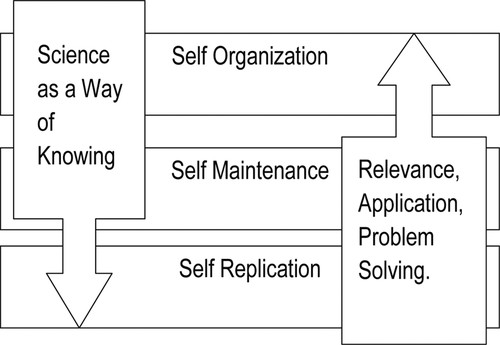
Figure 1. Essential learning expectations for BIO 181.
Table of Specifications: Obtaining Consensus on Amount of Time Spent on Various Topics
One of the issues that emerged in discussion with the various instructors was that there was a huge difference in focus by individual instructors. For example, some topics that were considered essential to one instructor were not covered at all by another instructor, and the amount of time that was devoted to various topics varied widely. We therefore developed a table of specifications (Table 2) that reflected common beliefs as to what should be covered and what proportion of the course should be devoted to the various topics.
A table of specifications is a two-dimensional table that relates key concepts, the levels of skills desired, and the amount of time or emphasis for each concept. A table of specifications should be developed before the assessment is written and before teaching begins (Kubiszyn and Borich, 2003). A table of specifications requires considerable time to construct due to the need to reach consensus as to which concepts will be taught in the course and the desired level of skill. In our opinion the benefits greatly outweigh the time invested because it ensures that the instructor teaches the required content at a designated level of comprehension (Bloom et al., 1971). The table of specifications (Table 2) ensured that a fair and representative sample of questions appeared on the pre/posttest measure and that thinking skills beyond concept comprehension—namely, application, analysis, synthesis, and evaluation—were included on the assessment (Notar et al., 2004).
Generation of a Course Assessment Tool
The table of specifications (Table 2) was used to guide the construction of a course assessment tool (pre/posttest). Instructors began the process by choosing questions from the question bank from the textbook publisher that were both content appropriate and representative of the required skill level, specifically, critical thinking, concept attainment, relevance/connections, and application (see Table 2). Some of the distracters were modified to include common misunderstandings observed during the cumulative experiences of the instructors. Such distractors allow assessment of higher-order thinking skills (Treagust, 1988; Rebello and Zollman, 2004). The distribution of questions reflected the fraction of time spent on each topic. A multiple-choice format was used to administer the test to hundreds of students, provide rapid feedback, and probe for various levels of understanding of the fundamental concepts taught in this course. This test initially consisted of 100 multiple-choice questions, each one categorized into four areas (see Table 2). The principal investigator of the grant created a bank of questions that was reviewed by the instructors and the department chair.
Students were given the pretest during the first week of the semester and a posttest that could be taken during the last week of the semester. The tests were administered online as a low-stakes assignment. Course points were awarded to students who completed the tests. No rewards were given for the correct answer.
The pre- and posttests were administered through Blackboard VISTA, beginning in Fall 2006. Examining the pretest results from Fall 2006 and Spring 2007 showed that, prior to taking the course, there were no significant differences among the sections of BIO 181. The similar pretest mean scores indicate that the various sections of BIO 181 contained students with similar background knowledge of biology. Comparison of pretest and posttest scores indicated that student learning occurred in all sections. However, data analysis of this initial trial revealed significant differences between sections taught by different instructors (unpublished data). There are various possible reasons for this difference: 1) Emphasis on the posttest exam may have varied from one instructor to another. For example, the effort made by students varied widely, as indicated by the amount of time on task (sometimes less than 10 min). 2) Difficulties with Blackboard VISTA were expressed by some students. 3) There may have been significant variation in course content between sections. This finding was used to foster further discussions to identify strategies that could be used to minimize the large discrepancies in student learning that was occurring between sections.
Developing a Common Syllabus
The table of specifications was used to draft a common syllabus. BIO 181 instructors from the university and local community colleges met nearly every week during the Fall 2007 semester to 1) develop common learning outcomes, 2) determine the essential content for BIO 181, 3) develop a common syllabus with matched reading assignments from a common text, and 4) build collaboration between local community colleges and the university.
In this process the following questions were discussed: What content could be eliminated? What content was absolutely necessary? What was the prerequisite knowledge that students needed? What knowledge could students obtain from text/tutorial, and what needed to be taught during class time? What were the applications of the information to other majors? The group agreed that the depth and breadth of the content taught should be consistent across all sections. A way to establish this consistency was to create a common syllabus and a set of course outline notes that everyone would use. These notes would consist of the minimum content that must be taught for a topic. Additional content could be added based on the preference of the instructor. Beyond the core course notes, it was agreed that the group would create a BIO 181 Toolbox, which would be an online resource for course instructors. This toolbox would include small-group activities, teaching strategies for specific concepts, PowerPoint presentations, relevant examples, websites, animations, videos, and so forth. The basic content of the course would be the same for everyone, but the details and method of course delivery could vary.
During the weekly meeting time, the instructors divided into working groups to develop a common course outline. One member of each group then rotated to another group to ask questions and provide input. This process continued until a common set and order of topics emerged (Table 3). Using this outline, a common syllabus, lecture outlines, and PowerPoint presentations were developed. These were posted on the instructors’ website for all to use as a basic resource along with animations and videos that instructors have found useful. Strategies for effectively teaching BIO 181 were also shared. These included active-learning strategies such as classroom response systems (clickers), think-pair-share, small-group work, Web-based interactive tutorials, and shorter lectures with more interaction with the students.
The content was organized so that the course began with a discussion of what science is and how science is done. The next topic was cells—something the students were already familiar with and at the heart of what the course was about. This led into a discussion of membranes and their lipid composition. The biochemistry of lipids was therefore taught in context. The structure of lipids was connected to their function and how this function was dependent on their chemical composition and interactions. The next topic was structure and replication of DNA, which led easily into the concept of the cell cycle and topics such as cell-cycle control and mitosis. Following this, students explored some of the issues of gene expression and a discussion of proteins as machines in the cells. As with lipids, the biochemistry of proteins was taught in context so that students could connect the structure of the various amino acids to the function of protein machines. At this point, they could also understand how variations arise through mutations and how these mutations are expressed as changed amino acids with altered properties. This then led into ideas of how mutations are inherited with discussions of meiosis and genetic crosses. Finally, students were exposed to the idea that cells need energy for everything they do. The structure and metabolism of carbohydrates was introduced in this context. Throughout the course an effort was made to connect new ideas to previous learning—a strategy that is known to increase student understanding and retention (Bransford et al., 2000).
It is important to note that despite using a common syllabus, instructors still have flexibility in how they teach the material. For instance, one instructor uses MasteringBiology (Pearson Publishing; http://masteringbiology.com/site/index.html; a widely used platform for tutorials, homework, and assessment) and extensive animations. Another instructor incorporates simulations that involve students and various props. Some instructors use PowerPoints in class, and others use them simply as an online summary of lecture material that is taught on the board in class.
Coordinating the Lectures with the Labs
The lab for BIO 181 has always been taken separately from the lecture; however, students must be enrolled in both simultaneously. Over time, the lecture and lab in BIO 181 had become disjointed, with many lab topics unrelated to lecture topics. The common syllabus enabled the lab and lecture material to be coordinated as all instructors were now teaching the material in the same order (Table 3).
The lab that accompanied BIO 181 was therefore redesigned to align with the lecture. Revisions included new topics with an emphasis on applying concepts in novel situations that require students to make interdisciplinary connections; alignment of topics with lecture; a new lab format that uses a quantitative approach, that is, a focus on equations, data sets, and graphical analysis; and an emphasis on the nature of science (Ueckert, unpublished results).
Incorporating Concepts of Chemistry in the Syllabus
One of the issues that emerged from our discussions was how the chemistry component of BIO 181 should be taught. Biology courses, especially introductory courses, are laden with chemistry—so much so that students often remark during the first weeks of the semester that it seems as if they are enrolled in a chemistry rather than a biology course. Facts and terminology are often taught in rapid succession in the belief that students cannot learn the biological concepts without first understanding such basic topics as atomic structure, redox reactions, polarity, bonding, pH, chemical reactions, properties of water, and energy. To address this issue we decided to 1) reduce the in-class time spent teaching basic chemistry by developing an online component of the course specifically devoted to chemistry and (2) teach more advanced concepts as they came up (i.e., on a “need-to-know” basis). Development of an online test and tutorial occurred in collaboration with the chemistry department; these were intended to teach basic chemistry concepts and to ensure students had a working knowledge of these concepts. Students were required to pass the chemistry test by the end of the first week in order to continue with the class. According to the National Science Education Standards, by the time students graduate from high school they should know about atomic structure, chemical bonding, and chemical reactions (NRC, 1996). The chemistry test thus served as a review of previously learned concepts.
More advanced topics in chemistry were taught in context, that is, when those chemistry topics were most crucial for the understanding of a specific biological concept. For instance, pH was introduced as enzymes were discussed; types of bonds and their significance in organisms were explored when students were learning about lipids and structure and function, and again when students were learning about protein structure and function; and redox reactions were taught during discussions of photosynthesis and respiration.
Increasing Relevance of Course Material
Another goal of the course redesign was to make the curriculum more effective by increasing relevance and including discussion of applications to real-world issues and societal challenges. The students were surveyed to determine the composition of the students enrolled in BIO 181. The student population was quite diverse. Only ∼20% of our students were biology majors. Far more (∼80%) were majors in health sciences, exercise science/athletic training, or forestry/environmental engineering or were undeclared.
Relevance was added to the course by making a concerted effort to include pertinent examples and case studies in lectures to add interest and appeal to the various audiences and designing in-class group tasks that required students to apply concepts to real-life applications. For example, Nabhan and Tewksbury's study (Freeman, 2005) on directed deterrence appealed to environmentalists/forestry majors and the molecular basis for genetic diseases appealed to students in health-related majors. We strove to make connections between topics and current events that students might be interested in such as the relationship of the cell cycle to cancer, the connection between mutations and phenylketonuria, and the role of DNA analysis in forensics, paternity tests, and so forth. Placing concepts in meaningful contexts is well known to increase students’ motivation to learn (Bransford et al., 2000; Hulleman and Harackiewicz, 2009).
Helping Students Understand Science as a Process
A concerted effort was made to teach biology not as a set of facts but rather as a process of discovery that has evolved over time, especially in terms of increased sophistication of tools and technology. We wanted students to realize that the findings of others become the foundation for future research, science has a cultural and societal component, and science may be controversial. For instance, at the beginning of the semester, students are given written descriptions of five major scientists and their experiments that played a role in the 200-yr debate on spontaneous generation. The scientists were from different countries and professions and held contradictory beliefs about spontaneous generations. Students form informal small groups to discuss their assigned scientists and experiments. A person from each group reports the main points to the class. The information is used to create a summary table of the contributions and lessons learned from each scientist. The goal is for students to discover that scientists come from various cultures and backgrounds, scientific experimentation has evolved to its present state, science is tentative, and people are reluctant to accept ideas different from their own. These understandings provide the foundation for studying the development of other theories and hypotheses during the semester.
Increasing Student Engagement through the Use of Class Response Systems
Most of the instructors used classroom response systems, or “clickers,” to involve students in their own learning. Clickers can be used in a number of ways, for example, to see what the students already know, to determine whether they have read the assigned reading, to check for student understanding, and to challenge students to connect ideas. Answer choices of common misconceptions and “trouble spots” observed in previous students are included. The students’ responses help to reveal gaps in their understanding. This information is used to alter lectures and teach what is needed to help students understand. Some multifaceted questions that require students to use what they know to build new understandings are also included. In this situation, the students answer the question (the instructor does not reveal the correct answer), then discuss their reasoning for choosing their answer in informal groups of two or three, and then reanswer the question. A discussion follows with students sharing their reasoning for their answer choices. These think-pair-share exercises result in beautiful teachable moments, and the students are eager to learn.
Clicker questions give students rapid feedback on their level of understanding and a preview of the types of questions that will be asked on quizzes and exams. Both of these are needed for students to not only learn but also feel good about their accomplishments and motivate them to learn more. Classroom response systems were implemented to check student understanding and foster small-group conversations about key concepts in large lecture settings. Students are asked to predict an answer to various problems or situations and try to convince their neighbor that their answer is correct. The ensuing discussions not only are of high energy but also involve connection of various concepts and the opportunity to clear up any misunderstandings.
Use of the clickers also allows students’ attendance to be tracked and compared with their performance in the course. We found a direct correlation between class attendance and academic success (similar to other findings, e.g., Van Blerkom, 1992; Gunn, 1993; Moore et al., 2003; Newman-Ford et al., 2008). Students who attended class earned higher course grades than those who did not. The scatterplot (Figure 2) suggests a strong linear trend between attendance score and course score in BIO 181. The correlation coefficient between attendance score and course score is .86 (based on 132 students).
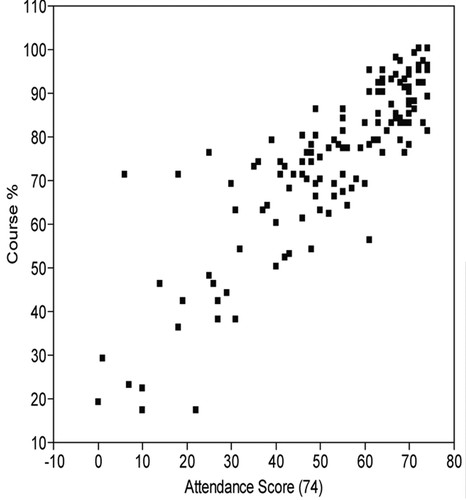
Figure 2. Bivariate fit of course score by attendance score.
Helping Students Engage with the Material
Most sections of BIO 181 have 120–240 students. To help students with the material, the following were used:
Web links that teach students to study for biology or assist in the enhancement/review of background knowledge and skills. The Web tutorials help with the transition from high school to college.
Scaffolded reading assignments that include learning objectives, smaller sections of text to read and answer questions about, and in-class questions on the reading assignment to increase student accountability.
Small-group work that engages students in the preparation and presentations of content applications.
Weekly Web-based quizzes. In introductory classes, students have often not learned how to study on a regular basis, and they often get behind on the material. To address this issue, weekly Web-based quizzes were implemented. These provided students with frequent feedback on their learning and helped them keep up with the material.
Implementing the Course Redesign
Students were informed of the innovations in BIO 181, the reason for the changes, and the anticipated improved learning outcomes using the department's website. In addition, a description of the changes and reasons for the changes were posted on the Blackboard VISTA course page and included in the syllabus. These changes and justification of the changes were also discussed by the instructors with the students early in the course. Students were given specific instructions on how to use Web-based technologies. It should be noted that Web-based quizzes, tutorials, and so forth were already in use across campus. Students therefore had many opportunities to learn and use the technology. There are numerous computer labs across campus and wireless capabilities in dorm rooms, classrooms, and labs. Instructional Technology Services provides a 24-h hotline to help students and faculty with technical problems.
RESULTS
We hypothesized that the redesigned course would have positive effects on student learning as evidenced by 1) lowering the DFW rate and increasing the number of As and Bs, 2) increasing consistency between sections, and 3) increasing student satisfaction.
Impact of the Redesign on Grades
Grade distribution data were collected over a 6-yr interval (3 yr prior to redesign, the year of the redesign, and 2 yr since the redesign was implemented). Figure 3 shows that over the 6-yr interval, the average DFW rate fell across sections. These changes are statistically significant, as linear regression analysis shows there is a significant negative correlation over time (F1,9 = 9.659, R2 = 0.518, p = 0.013). Moreover, using the t-test, there is a significant difference between %DFW before (mean = 34.46) and after (mean = 26.25) the change (t = 4.491, df = 7, p = 0.003).
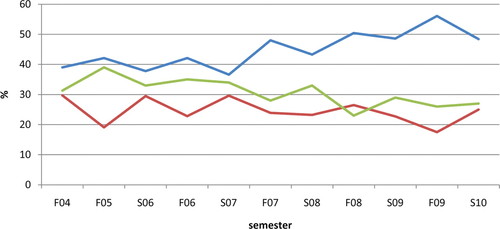
Figure 3. Average grade distributions (%) in all sections of BIO 181 over a 6-yr interval. The redesign process occurred during academic year (AY) 2007 and was implemented across all sections in AY 2008. Average grade distributions for each semester were obtained by adding numbers of students in all sections obtaining an AB, C, or DFW that semester and dividing by the total number of BIO 181 students that semester. Blue, %AB; red, %C; green, %DFW.
The percentage of Cs remained fairly constant over the 6-yr interval (Figure 3). Regression analysis shows no significant change over time (F1,9 = 1.357, p = 0.274). Furthermore, a t-test comparing the mean %C before (26.14) and after (22.925) the redesign showed no significant change (t = 1.060, df = 7, p = 0.325).
The percentage of As and Bs increased both during the redesign process and after the redesign was implemented (Figure 3). This finding is statistically significant, as linear regression analysis reveals that there is a significant positive correlation over time (F1,4 = 15.329, R2 = 0.589, p = 0.004). Moreover, there is a significant difference between the mean %AB before (39.52) and after (50.88) the change (t = −5.603, df = 7, p = 0.001).
The data in Figure 3 and associated text show a significant improvement in student grades after the course redesign, and the variation between sections is addressed later in Figures 6 and 7 and associated text. However, it is formally possible that these changes merely reflect grade inflation caused by more lenient grading standards. To address this possibility, we examined pre/posttest scores. These scores were less subject to the possibility of grade inflation as the questions used were the same as those used prior to the redesign, and there was no change in the way these tests were administered before versus after the redesign. Figure 4 shows the difference between posttest and pretest scores in various sections over a 4-yr span (beginning in Fall 2006). As seen in the figure, there is a general trend toward an increase in posttest minus pretest gain after the redesign. Figure 4. Average difference between pretest and posttest scores (score difference) in the various sections of BIO 181 over a 4-yr interval. The redesign occurred during AY 2007 and was implemented across all sections in AY 2008. Figure 5. Box-and-whisker plot of difference in posttest minus pretest score before (semester type 1) and after (semester type 2) the course redesign. There is a single outlier (small circle) above the box representing data from before the redesign (also apparent in Figure 4). Figure 6. DFW rates over a 6-yr interval (11 semesters) in various sections of BIO 181. The redesign process occurred during AY 2007 and was implemented across all sections in AY 2008.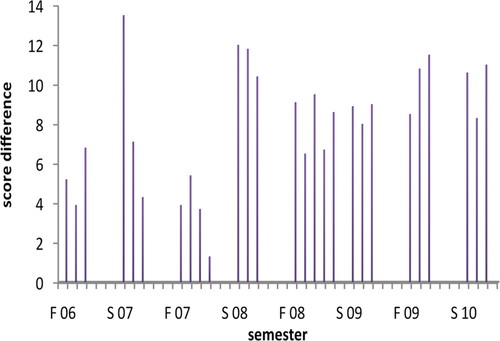
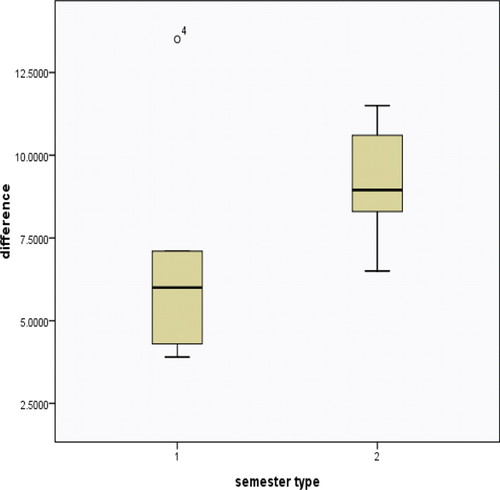
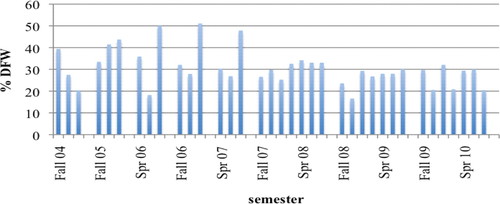
Analysis using a box-and-whisker plot (Figure 5) shows that these changes are substantial. In all such plots, the top of the box represents the 75th percentile, the bottom of the box represents the 25th percentile, and the line in the middle represents the 50th percentile (median). The whiskers (the lines that extend out from the top and bottom of the box) represent the highest and lowest values that are not outliers or extreme values. Outliers (values that are between 1.5 and 3 times the interquartile range) and extreme values (values that are more than three times the interquartile range) are represented by circles beyond the whiskers.
The finding that after implementation of the course redesign there is a significant improvement in posttest minus pretest scores confirms the observations from the grade data and suggests there was not a general trend toward grade inflation over this time.
Impact of the Redesign on Consistency between Sections
One of the goals of the redesign was to reduce the variability between sections of BIO 181. DFW rates were determined for each section before, during, and after the redesign. Figure 6 shows the DFW rate for various sections during this 5-yr interval. From the graph, it is clear that the variability in DFW rates during and after the redesign process is much reduced compared with the variability before the redesign. The decrease in variability between instructors is also clear from the box-and-whisker plot shown in Figure 7. Figure 7. Box-and-whisker plot of %DFW before (semester type 1) and after (semester type 2) the course redesign. The top of the box represents the 75th percentile, the bottom of the box represents the 25th percentile, and the line in the middle represents the 50th percentile (median). The whiskers (the lines that extend out the top and bottom of the box) represent the highest and lowest values that are not outliers (values that are between 1.5 and 3 times the interquartile range) or extreme values (values that are more than 3 times the interquartile range).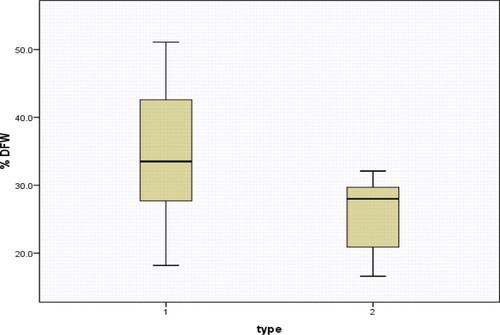
A reduction in variability between sections was also suggested by the data comparing the difference between pretest and posttest scores (see Figure 4). For example, prior to the redesign the posttest minus pretest score varied during one semester (Spring 0707) from 4.3 to 13.5 points (a 9.2-point difference). After the redesign, the maximum difference in any one semester was just three points. However, when these apparent differences were examined with a box-and-whisker plot (Figure 5), it became clear that although the median point difference increased after the redesign, the variability between sections was unchanged. Future work with this course will use these data to address issues concerning the pre- and posttest. For example, we will examine whether the pre- and posttest questions are well matched to the information that is actually taught across the various sections.
Impact of the Redesign on Student Satisfaction
A 22-item survey was administered to all four sections of BIO 181 at the beginning of the Fall 2006 semester to find out more about the students enrolled in BIO 181 and to determine whether the different sections were similar in composition. There were no significant differences in demographics among the four sections in terms of gender, ethnic make-up, or major. The Fall 2006 results established the baseline that was used to compare student satisfaction after full implementation of the course redesign. The percentage of agreement to each of the four questions was compared with the baseline data to determine whether a change in attitude had occurred from the beginning of the redesign in Fall 2006 to Spring 2010 (see Figure 8). Instructor impact on student responses was minimized by the researcher administering the anonymous survey in the lab portion of the course. All students enrolled in BIO 181 lab in Fall 2009 and Spring 2010 were surveyed. Students are required to enroll in both the lecture and lab portions of the course. Figure 8. Change in student attitudes toward the course over time. Percentage of agreement with four statements (see text) were obtained from all students enrolled in BIO 181 for each of three semesters (Fall 2006, prior to the redesign, and Fall 2009/Spring 2010, after the redesign).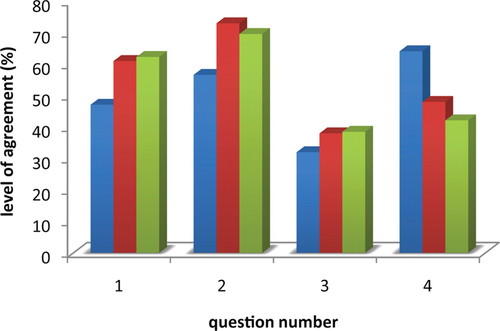
Students were asked to rate their level of agreement on 14 items related to interest, confidence, and self-efficacy. A five-point rating scale was used, ranging from strongly disagree (value = 1) to strongly agree (value = 5). Data for the following four statements are shown in Figure 8:
| 1. | I feel confident learning basic concepts in this course. | ||||
| 2. | I think this course material was useful for me to learn. | ||||
| 3. | I'm confident I understood the most complex material presented. | ||||
| 4. | Biology is difficult to understand. | ||||
Figure 8 shows that since the course redesign, students have become more confident in their abilities to learn biology (questions 1 and 3), and they have increased their perception that the material is useful for them to learn (question 2). In addition, their perception that biology is difficult to understand has decreased (question 4). The percentage of agreement difference between Fall 2006 and Fall 2009/Spring 2010 is statistically significant, as shown by a P test comparing Fall 2006 with Fall 2009 or Spring 2010, with an α of .05%. However, comparison of the two semesters since the redesign shows that there is no statistical significance at the 5% level between Fall 2009 and Spring 2010. This results shows that the revision of BIO 181 has increased student satisfaction.
DISCUSSION
The redesign of BIO 181 was conducted with the goal to improve the student success rate in this course. In this section we discuss both the benefits and the challenges of redesigning this course.
Benefits of the Redesigned Course
Our findings described above indicate that the redesigned course had a clear impact on student success rates. There are several major benefits of this improved success rate. First and most obviously, the redesigned course allows students to proceed with their course of study more quickly. This is particularly relevant as BIO 181 is a gateway course that is required for all other courses in biology. Second, there are financial implications of the redesigned course for not only the students but also the university and the department. For example, with a class size of 1000 students per year, every 1% reduction in DFW rates corresponds to approximately 10 students fewer retaking the course. We have achieved an approximately 8.5% reduction in DFW rates (from an average of 35.75% before the redesign to an average of 27.25% after the redesign), which translates to about 100 fewer students retaking BIO 181 per year. This is the equivalent of almost an entire section and therefore an additional instructor. This also equates to four lab sections (24 students/lab section), plus more than one teaching assistant (TA; each TA teaches three sections). However, the number of lab sections has increased due to an increase in enrollment. Institutional data on the number of repeats are not available; however, the change in grade distribution implies that fewer students are repeating the course as the students who traditionally repeat the class would have earned a D or F or withdrawn from the class. Those numbers have been significantly reduced, as seen in Figures 3, 6, and 7.
A third major benefit of the redesigned course is that we can now provide a syllabus and helpful tools to new (often part-time) faculty hired to teach BIO 181 due to sabbaticals, increased enrollment, illness, and so forth. This helps new instructors to teach this course effectively and to cover material that is consistent with the goals of the course and department. The materials to teach BIO 181 are conveniently located on Blackboard VISTA and include a toolbox containing videos, animations, teaching strategies, and a PowerPoint skeleton for the various lectures.
Finally, an additional benefit of the redesign is that it led to a more collegial atmosphere among instructors of BIO 181. Instructors of the course are now more actively engaged in talking to each other about teaching strategies and sharing newly found resources such as animations.
Challenges Faced in the Revision of BIO 181
Revising a curriculum is a difficult challenge. One issue faced initially was maintaining the autonomy of the instructors while developing a common syllabus. In addition, although most instructors realized that course adjustments needed to be made, some believed the problem could largely be resolved if we adopted a different textbook. Some instructors were also resistant to engaging in time-consuming discussions when they already felt overworked. Moreover, the instructors had very different research interests and initially had different ideas about topics that should be included. Eventually, however, the differences became an asset as the group became more comfortable with the project and focused on the task at hand. Negotiations resulted in a table of specifications that proved to be very helpful as decisions were made on what to teach and how long to spend on each concept. We found it was crucial to have open discourse and sharing of progress and even obstacles that were encountered. We found that involving all interested parties in the designing and implementation strengthened the final product and helped to reassure faculty that they were an integral part of the redesign.
There were also technical difficulties. One of the initial challenges was developing and administrating the pre/posttest. Placing the test on Blackboard VISTA was time consuming and frustrating. After administrating the pretest, it was realized that some diagrams had not uploaded successfully, a couple of wrong answers existed in the answer key, and there was a duplicate question. In addition, the 100-question test proved to be too long. The test was therefore revised to contain just 50 questions. Another technical challenge concerned the use of clickers. The classroom response systems were new to Northern Arizona University (NAU) in 2006. Learning to use them was time consuming and sometimes exasperating, and, indeed, some of the instructors tried using them but gave up.
CONCLUSION
Curriculum revision of BIO 181 has been a long, slow process involving a plethora of meetings and decisions. The result is a complete revamping and reordering of the concepts taught, incorporation of technology, and alignment of the laboratory exercises with lecture. A major change was the incorporation of active-learning strategies such as think-pair-share, classroom response systems (clickers), and small-group work. Research has consistently shown that all students, including college science students, learn more when actively engaged (Ueckert and Gess-Newsome, 2007). Active-learning strategies mirror many of the processes of scientific inquiry and accommodate different interests and learning references.
The impact of redesigning our introductory biology course for majors was measured by comparing pre/posttest exam scores as well as grade distributions and student satisfaction. The redesign resulted in a decrease in the DFW rate, an increase in the number of As and Bs, improved posttest minus pretest scores, increased student satisfaction, and reduced variability between sections.
BIO 181 is a course that is approved for articulation with the community colleges. While we see the benefits for the redesign of BIO 181 as impacting primarily NAU, we would also like to use this opportunity to expand the conversation with local community colleges. Two community college instructors participated in the redesign team. Both teach BIO 181 at their respective institutions and have contacted us about wanting to share ideas about teaching this course. We believe that this partnership will improve the articulation of the course across institutions and may spark interest in the modification of this course beyond NAU.
Finally, we note that changing curricula is challenging and should be a continuing venture as demanded by advances in research, technology, access to Internet resources, and knowledge about teaching and learning. The response by postsecondary institutions to reform biology education appears to be slow and isolated; that is, a course or two may be revised by a department or institution, but there is no concerted effort to change biology at the national level. Perhaps the absence of a systemic effort to reform postsecondary science is due to the lack of leadership provided by the documents developed for elementary and secondary education. However, reforming the content and teaching of biology at the university level is currently receiving renewed attention largely due to the BIO2010: Transforming Undergraduate Education for Future Research Biologists and the Scientific Foundations for Future Physicians report (NRC, 2003; Association of American Medical Colleges and Howard Hughes Medical Institute, 2009). The recommendations of BIO2010: Transforming Undergraduate Education for Future Research Biologists are motivating us to pursue additional collaborations to strengthen interdisciplinary and cross-disciplinary connections in BIO 181. The anticipated goal is the incorporation of complex problem solving into both the introductory chemistry and biology courses.
ACKNOWLEDGMENTS
We thank the BIO 181 instructors for their participation in the course redesign and collection of data. In particular, we thank Kitty Gehring, Rick Holloway, Linn Montgomery, Kiisa Nishikawa, Peggy Pollak, Rich Posner, and Maxine Rausche. We also acknowledge the work of Carol Haden in designing the student survey, Julie Gess-Newsome for her guidance and support during the redesign process, and Maribeth Watwood, chair of the Department of Biological Sciences. This work was supported by an Arizona Board of Regents Learner-centered Education grant.


